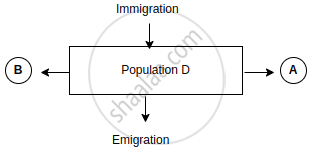Advertisements
Advertisements
Question
On the basis of the demographic data of a country given below, construct an age pyramid and explain whether the population is stable, declining or growing.
| Age group | No. of individuals |
| Pre-reproductive | 20,000 |
| Reproductive | 15,000 |
| Post-reproductive | 10,000 |
Solution
In the given data, the number of pre-reproductive individuals is very large, the number of reproductive individuals is moderate, while post-reproductive individuals are fewer. This type of age pyramid shows that the population is "growing". The rate of growth depends on the size of the pre-reproductive population. This type of population growth is observed in developing countries like India, Bangladesh.

APPEARS IN
RELATED QUESTIONS
Which country has the highest and lowest growth rate of the population respectively?
What is the impact of migration?
What is population growth? What does population change indicate for an area?
What would be the growth rate pattern, when the resources are unlimited?
Which of the following may be interpreted as a spontaneous effort to achieve a better balance between population and resources?

Observe the schematic representation given above and answer the following questions:
- Identify A and B.
- Calculate the growth rate of bacteria in a curd sample, where 1 million bacteria increased to two million, within a period of one hour.
Analyse the main features of Phase-III (1951 - 81) of growth of population in India.
A: Population of a region does not change.
R: Birth rate, death rate and migration affect the population of a region.
A: The population of a region does not change.
R: Birth rate, death rate and migration affect the population of a region.
Assertion (A): Population of a region does not change.
Reasoning (R): Birth rate, death rate and migration affect the population of a region.
